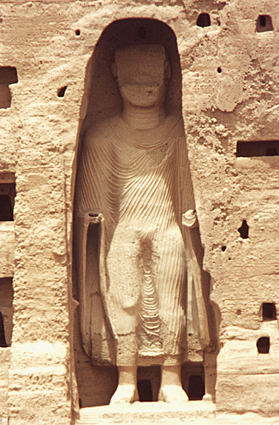
Bamiyan Buddha statue, Afghanistan, 1974. Photo by Volker Thewalt, and used under a Creative Commons license.
Of course, Hagia Sophia is only one example of how humans have built, rebuilt, modified internally, expanded, and restored a sacred structure. In this second half of Module 4, we’re going to read about other sacred structures and compare and contrast the habits, beliefs, and values they reveal or represent.
Here are the readings and activities for the second half of this week:
- Read the following articles, taking notes as described in #2 below:
- “The Great Mosque of Djenné”
- “Mosque-Cathedral of Córdoba”
- “Ise Grand Shrine: Japan’s Most Sacred Shrine”
- “Rebuilding Every 20 Years Renders Sanctuaries Eternal”
- “Buddhas of Bamiyan” (Note: these statues are often analyzed and interpreted as regional art, but for our purposes, we’re going to also consider them as massive Buddhist sculptures whose construction, maintenance, destruction, and reincarnation allow for fruitful comparisons and contrasts with the other structures about which we’re learning.)
- “Bamiyan Buddhas rise again with 3D light projection”
- “Friends Meeting House”
- “Meeting House of the Friends Meeting of Washington”
- Renovation plans for the Friends Meeting House in Washington, D.C.
- Take notes, answering these questions about the structures above as well as about the Hagia Sophia.
- What distinctive materials were used in these structures?
- What aspects of the structures are similar? Which structures have unique features, and what are they?
- What similar or disparate threats have the structures faced?
- How do worshippers or others who use each structure approach its preservation or restoration?
- How has structure influenced cultural practice, and vice versa?
- Create a two-dimensional visualization—a sketch, a concept map, mind map, or topic map, for example—that answers this question: How do the users of these structures—be they temples, shrines, meeting houses—balance preservation of tradition with the realities and needs of the modern world? Your visualization should draw on the notes you took in #2 above. Please note that there is no single correct way to visualize the answer to this question. As long as your visualization is legible, thoughtful, and comprehensible, it will be acceptable.
- Take a photo or screen shot of your visualization for #3 and post it to the class blog. Please save the original version, as you’ll be iterating and improving upon it for one of this course’s larger assignments.
- Respond to the posts of others in your group. You might, for example, say what you most appreciate about the visualization, what parts of it you think would benefit from clarification, or what additional details or concepts might be added to it.
Post due Saturday, February 6 by 11 p.m. Before publishing, remember to check the categories for your group number and the assignment name.